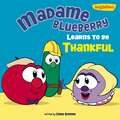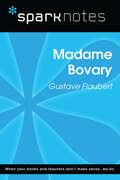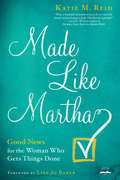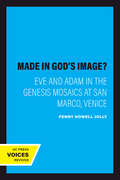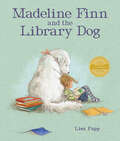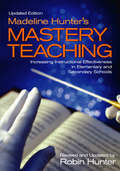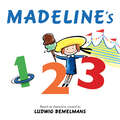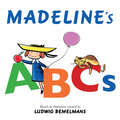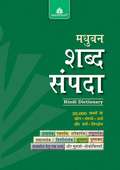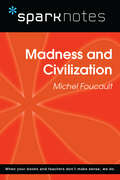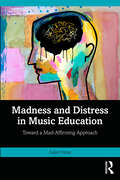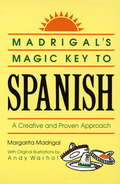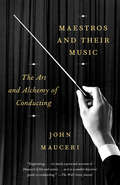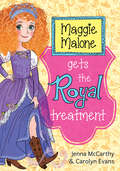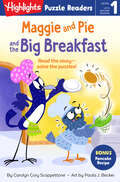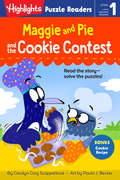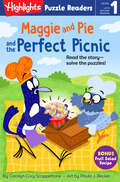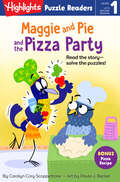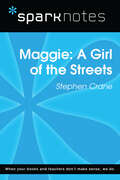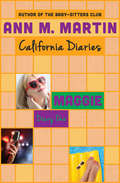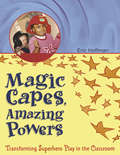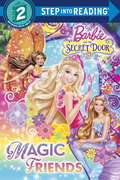- Table View
- List View
Madame Blueberry Learns to Be Thankful / VeggieTales (Big Idea Books / VeggieTales)
by Cindy KenneyPresented in the 8x8 softcover format, complete with stickers for additional fun, VeggieTales’ Madame Blueberry Learns to Be Thankful helps little ones see how important it is to be thankful for what they have. When Madame Blueberry needs to begin rebuilding her tree house, her friends Bob and Larry come to help. But when they begin to talk about getting more and more things that might make the job easier, she reminds them that they should be happy with what they have.
Madame Bovary (SparkNotes Literature Guide Series)
by SparkNotesMadame Bovary (SparkNotes Literature Guide) by Gustave Flaubert Making the reading experience fun! Created by Harvard students for students everywhere, SparkNotes is a new breed of study guide: smarter, better, faster. Geared to what today's students need to know, SparkNotes provides: *Chapter-by-chapter analysis *Explanations of key themes, motifs, and symbols *A review quiz and essay topicsLively and accessible, these guides are perfect for late-night studying and writing papers
Made Like Martha: Good News for the Woman Who Gets Things Done
by Katie M. Reid Lisa-Jo BakerAn invitation for overachievers to discover what it means to rest as God's daughters without compromising their God-given design as doers.Though she didn't sit at Jesus's feet like her sister Mary, biblical Martha was loved just as she was--and you are too. This practical resource invites modern-day Marthas to sit down spiritually as they exchange try-hard striving for hope-filled freedom without abandoning their doer's heart in the process. Doers need to be affirmed in their innate design to do rather than sit, yet also be reminded that they don't have to overdo it in order to be worthy. This book is not an exhortation to add or subtract things off your to-do list, but it is an invitation to embrace the "good" of the Good News. Here is an offer to step into your position as a daughter of God and to enjoy life as a doer.
Made in God's Image?: Eve and Adam in the Genesis Mosaics at San Marco, Venice (The Discovery Series #4)
by Penny Howell JollyThis title is part of UC Press's Voices Revived program, which commemorates University of California Press’s mission to seek out and cultivate the brightest minds and give them voice, reach, and impact. Drawing on a backlist dating to 1893, Voices Revived makes high-quality, peer-reviewed scholarship accessible once again using print-on-demand technology. This title was originally published in 1997.This title is part of UC Press's Voices Revived program, which commemorates University of California Press’s mission to seek out and cultivate the brightest minds and give them voice, reach, and impact. Drawing on a backlist dating to 1893, Voices Revived</DIV
Made to Crave Action Plan Participant's Guide: Your Journey to Healthy Living
by Lysa Terkeurst Christine Anderson Ski ChiltonAccording to New York Times bestselling author Lysa TerKeurst, craving isn’t a bad thing, but we must realize God created us to crave so we’d ultimately desire more of Him in our lives. Many of us have misplaced that craving, overindulging in physical pleasures instead of lasting spiritual satisfaction. Made to Crave Action Plan—a follow-up curriculum to Made to Crave—will help women implement a long-term plan of action for healthy living. In this six-session video-based study, women will be encouraged by Bible teaching from Lysa, uplifted by testimonies from women like Christian music chart-topper Mandisa, and empowered with healthy living tips from Dr. Ski Chilton, an expert in molecular medicine. This curriculum will help women who found their “want to” by participating in the Made to Crave study master the “how to” of living a healthy physical life as well as cultivate a rich and full relationship with God. Made to Crave Action Plan gives women of all ages Biblical encouragement for both their physical and spiritual journeys plus healthy living tips for use in their everyday lives. Designed for use with the video.
Made to Crave Participant's Guide: Satisfying Your Deepest Desire with God, Not Food
by Lysa TerkeurstAccording to bestselling author Lysa TerKeurst, craving isn’t a bad thing, but we must realize God created us to crave so we’d ultimately desire more of Him in our lives. Many of us have misplaced that craving, overindulging in physical pleasures instead of lasting spiritual satisfaction. For a woman struggling with unhealthy eating habits, Made to Crave will equip her to: Break the “I’ll start again Monday cycle” and start feeling good about herself today Stop beating herself up over the numbers on the scale and make peace with the body you’ve been given Discover how weight loss struggles aren’t a curse but, rather, a blessing in the making Replace justifications that lead to diet failure with empowering go-to scripts that lead to victory Eat healthy without feeling deprived Reach a healthy weight goal while growing closer to God through the process Designed for use with the video.
Madeline Finn and the Library Dog
by Lisa PappA delightfully warm, encouraging story of a young girl and the special library dog who helps her develop patience, acceptance, and confidence as she learns to read, from award-winning author-illustrator Lisa Papp.Madeline Finn does NOT like to read. But she DOES want a gold star from her teacher. Except stars are for good readers, for understanding words, and for saying them out loud—things that Madeline Finn doesn't believe she can do.Fortunately, Madeline Finn finds a little help when she meets Bonnie, a library dog. Reading out loud to Bonnie isn't so bad, and when Madeline Finn gets stuck, Bonnie doesn't mind. As it turns out, it's fun to read when you're not afraid of making mistakes. Bonnie teaches Madeline Finn that it's okay to go slow—and, most importantly, to keep trying.Lisa Papp offers an inspiring and comforting story, perfect for new readers who just need a little confidence to overcome their fears.
Madeline Hunter's Mastery Teaching: Increasing Instructional Effectiveness in Elementary and Secondary Schools
by Mr Robin HunterUpdated Edition of Bestseller Madeline Hunter’s authoritative guide to effective instruction, newly updated and expanded for today’s learners! This classic resource is the best-selling guide to rigorous standards-based instruction that covers teaching to both sides of the brain, teaching for meaning and retention, and teaching to real-life situations. This exciting new edition features: Instruction, learning, motivation, guided practice, and behavior integrated into a comprehensive and effective model for classroom teaching Newly updated and expanded content to encompass teaching for independent learning Teaching tips, classroom examples, recommended readings, a new comprehensive index, and a discussion guide for each chapter
Madeline's 123 (Madeline)
by Ludwig BemelmansLearn your numbers and counting with the bravest girl in the world, Madeline!Ludwig Bemelmans's beloved character Madeline is back, and here to teach young readers how to count. Using familiar faces and settings from the classic and beloved Madeline books, readers will delight in learning how to count 1 through ten with Madeline!
Madeline's ABCs (Madeline)
by Ludwig BemelmansCome learn the ABC's with the bravest girl in the world, Madeline!Ludwig Bemelmans's beloved character Madeline is back, and here to teach a new audience the alphabet. She'll use examples of each letter from the classic Madeline book, so readers will recognize both settings and characters as she guides the youngest readers through learning each of the letters.
Madhuban Sabda Sampada: Hindi Dictionary
by Vikas Publishing House Pvt. Ltd.सभी शब्दों के विभिन्न अर्थ, वर्ण-विच्छेद, व्याकरणिक-कोटि, अनेकार्थक शब्द, ऊनार्थक शब्द, एकार्थक शब्द, पुनरुक्त शब्द, वाक्यांश के लिए एक शब्द, विपरीतार्थक शब्द, श्रुतिसमभिन्नार्थक शब्द, समानार्थक शब्द, समूहार्थक शब्द और अर्थ सहित मुहावरे व लोकोक्तियाँ
Madhura Kannada Bhaga 1: ಮಧುರ ಕನ್ನಡ ಭಾಗ- 1
by National Institute of Open Schoolingಇದು ಕನ್ನಡ ಸಾಹಿತ್ಯಕ್ಕೆ ಶೈಕ್ಷಣಿಕ ಉಲ್ಲೇಖ, ಕನ್ನಡ ಸಾಹಿತ್ಯದಲ್ಲಿ ಸಂಶೋಧನೆ ನಡೆಸುವ ಆಕಾಂಕ್ಷಿಗಳಿಗೆ ಇದು ಉಪಯುಕ್ತವಾಗಿದೆ.
Madness and Civilization (SparkNotes Philosophy Guide)
by SparkNotesMadness and Civilization (SparkNotes Philosophy Guide) Making the reading experience fun! SparkNotes Philosophy Guides are one-stop guides to the great works of philosophy–masterpieces that stand at the foundations of Western thought. Inside each Philosophy Guide you&’ll find insightful overviews of great philosophical works of the Western world.
Madness and Distress in Music Education: Toward a Mad-Affirming Approach
by Juliet HessMadness and Distress in Music Education offers an in-depth exploration of mental health and emotional distress in the context of music education, offering new ways of thinking about these experiences and constructing ways to support distress through affirming pedagogy, practices, and policies in music education. Centering the lived experiences of 15 people in a range of roles across music education who self-identify an issue with their mental health, the volume addresses impacts on both students and educators. The author draws on Mad Studies and disability studies to present new paradigms for thinking about Madness and distress in the music context. An essential resource for music educators, music education researchers, and preservice students seeking to understand the complexities of mental health in the music classroom, this book considers how people conceptualize their mental health, how distress impacts participation in music education, how music education may support or exacerbate distress, and what supports for distress can be implemented in music education.
Madrigal's Magic Key to Spanish: A Creative and Proven Approach
by Margarita MadrigalUse the English you already know to quickly learn the basics of Spanish with this unique, accessible guide featuring original illustrations by Andy Warhol—from one of America&’s most prominent language teachers. Read, write, and speak Spanish in only a few short weeks! Even the most reluctant learner will be astonished at the ease and effectiveness of Margarita Madrigal&’s unique method of teaching a foreign language. Completely eliminating rote memorization and painfully boring drills, Madrigal&’s Magic Key to Spanish is guaranteed to help you:• Learn to speak, read, and write Spanish quickly and easily• Convert English into Spanish in an instant• Start forming sentences after the very first lesson• Identify thousands of Spanish words within a few weeks of study• Travel to Spanish-speaking countries with confidence and comfort• Develop perfect pronunciation, thanks to a handy pronunciation keyWith original black-and-white illustration by Andy Warhol, Madrigal&’s Magic Key to Spanish will provide readers with a solid foundation upon which to build their language skills.
Maestros and Their Music: The Art And Alchemy Of Conducting
by John MauceriAn exuberant, uniquely accessible, beautifully illustrated look inside the enigmatic art and craft of conducting, from a celebrated conductor whose international career has spanned half a century. John Mauceri brings a lifetime of experience to bear in an unprecedented, hugely informative, consistently entertaining exploration of his profession, rich with anecdotes from decades of working alongside the greatest names of the music world. With candor and humor, Mauceri makes clear that conducting is itself a composition: of legacy and tradition, techniques handed down from master to apprentice--and more than a trace of ineffable magic. He reveals how conductors approach a piece of music (a calculated combination of personal interpretation, imagination, and insight into the composer's intent); what it takes to communicate solely through gesture, with sometimes hundreds of performers at once; and the occasionally glamorous, often challenging life of the itinerant maestro. Mauceri, who worked closely with Leonard Bernstein for eighteen years, studied with Leopold Stokowski, and was on the faculty of Yale University for fifteen years, is the perfect guide to the allure and theater, passion and drudgery, rivalries and relationships of the conducting life.
Maggie Malone Gets the Royal Treatment
by Carolyn Evans Jenna MccarthyWalking a mile in someone else's shoes can be a royal pain Everyday is Freaky Friday for Maggie Malone and her Mostly Magical Boots. Whenever she slips on the MMBs, Maggie gets to be whomever she wants for a whole day. And whose life could be more fun to try on than the glamorous Princess Wilhelmina of Wincastle's? Even better, Wilhelmina is a bridesmaid in the Royal Wedding of the Century! But even pampered princesses have whopper-sized problems-and hers is an evil archenemy named Penelope. Will she survive Penelope's tricks or will the whole wedding turn into a royal disaster?
Maggie and Pie and the Big Breakfast (Highlights Puzzle Readers)
by Carolyn Cory ScoppettoneHighlights Puzzle Readers offer an innovative approach to learning that integrates puzzles and stories to develop motivated, confident readers. These Level 1 books are perfect for kids who are reading simple sight words and sounding out decodable text.Fans of Amelia Bedelia will love these bird buddies! Maggie, a scatter-brained magpie, and Pie, a rule-following pigeon, love to cook together, but sometimes Maggie gets a little mixed up! In this Level 1 Highlights Puzzle Reader, kids solve visual logic puzzles to help find the right ingredients. With a bonus recipe so kids can make their own applesauce pancakes, Maggie and Pie and the Big Breakfast is perfect for beginning readers.
Maggie and Pie and the Cookie Contest (Highlights Puzzle Readers)
by Carolyn Cory ScoppettoneHighlights Puzzle Readers offer an innovative approach to learning that integrates puzzles and stories to develop motivated, confident readers. These Level 1 books are perfect for kids who are reading simple sight words and sounding out decodable text.Maggie and Pie are bird buddies that love to cook—but sometimes Maggie gets a little mixed up! As they bake cookies in this Level 1 Highlights Puzzle Reader, kids can use clues in the story to find the supplies they need in simple visual puzzles that double as picture support for the text. With a bonus recipe, Maggie and Pie and the Cookie Contest will appeal to junior chefs who are just discovering reading.
Maggie and Pie and the Perfect Picnic (Highlights Puzzle Readers)
by Carolyn Cory ScoppettoneHighlights Puzzle Readers offer an innovative approach to learning that integrates puzzles and stories to develop motivated, confident readers. These Level 1 books are perfect for kids who are reading simple sight words and sounding out decodable text.Maggie and Pie are bird buddies that love to cook—but sometimes Maggie gets a little mixed up! As they make fruit salad, in this Level 1 Highlights Puzzle Reader, kids can use clues in the story to find the supplies they need in simple visual puzzles that double as picture support for the text. With a bonus recipe, Maggie and Pie and the Perfect Picnic will appeal to junior chefs who are just discovering reading.
Maggie and Pie and the Pizza Party (Highlights Puzzle Readers)
by Carolyn Cory ScoppettoneHighlights Puzzle Readers offer an innovative approach to learning that integrates puzzles and stories to develop motivated, confident readers. These Level 1 books are perfect for kids who are reading simple sight words and sounding out decodable text.Fans of Amelia Bedelia will love these bird buddies! Maggie, a scatter-brained magpie, and Pie, a rule-following pigeon, love to cook together, but sometimes Maggie gets a little mixed up! In this Level 1 Highlights Puzzle Reader, kids solve visual logic puzzles to help find the right ingredients. With a bonus recipe so kids can make their own pizza, Maggie and Pie and the Pizza Party is perfect for beginning readers.
Maggie: A Girl of the Streets (SparkNotes Literature Guide Series)
by SparkNotesMaggie: A Girl of the Streets (SparkNotes Literature Guide) by Stephen Crane Making the reading experience fun! Created by Harvard students for students everywhere, SparkNotes is a new breed of study guide: smarter, better, faster. Geared to what today's students need to know, SparkNotes provides: *Chapter-by-chapter analysis *Explanations of key themes, motifs, and symbols *A review quiz and essay topicsLively and accessible, these guides are perfect for late-night studying and writing papers
Maggie: Dawn, Sunny, Maggie, Amalia, And Ducky (California Diaries #3)
by Ann M. MartinMaggie makes everything she does look easy--but there's a high price to pay for perfectionMaggie Blume does everything right. She gets straight A's, is a talented pianist, and was just named the youngest poetry editor of the school's literary magazine, Inner Vistas. She makes the life of a successful thirteen-year-old look easy.For Maggie's father, nothing but perfect will do. Not only is he obsessed with his job as a studio executive, he expects Maggie to have a detailed plan for her life, which unfortunately leaves no room for her true passion: music.Once Maggie's friends learn of her talent, they help her land a spot as the lead singer for Vanish, the band managed by her friend Amalia. Maggie could never share this news with her dad, so when she has to choose between going to his movie opening and the battle of the bands, she takes a huge risk to make sure she's able to do it all--perfectly.This ebook features an illustrated personal history of Ann M. Martin, including rare images from the author's collection.
Magic Capes, Amazing Powers
by Eric HoffmanHeroes, villains and saving the day! Magic Capes, Amazing Powers explores why children are so strongly attracted to superhero and weapons play, and addresses the resulting concerns of parents and teachers. Unique in its approach to this wildly popular type of play, Magic Capes describes how teachers can use redirection, story-telling, dramatic play materials, anti-bias curriculum and clear limit-setting to guide superhero play in a positive direction that allows children to play and satisfies the concerns of adults.Eric Hoffman is the program coordinator for the Cabrillo College Children's Center in Aptos, CA. He has worked with preschool-age children since 1970 and cofounded the CRADLE Project, which assists teachers and parents who do conflict resolution with children.
Magic Friends (Barbie and the Secret Door)
by Chelsea EberlyGirls ages 4 to 6 will love learning to read on their own with this Step 2 Step into Reading leveled reader based on Barbie's latest film, releasing in fall 2014.
